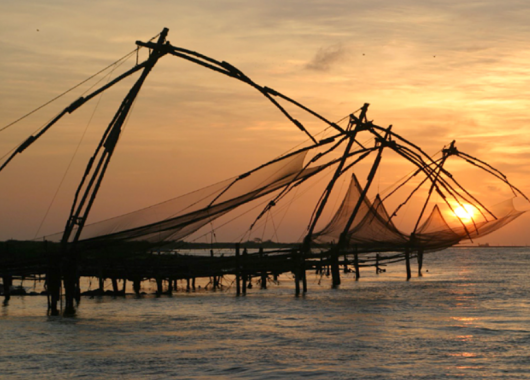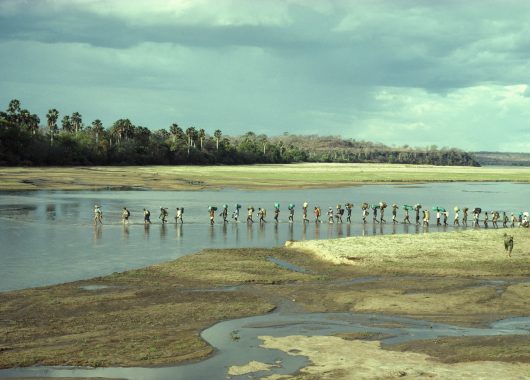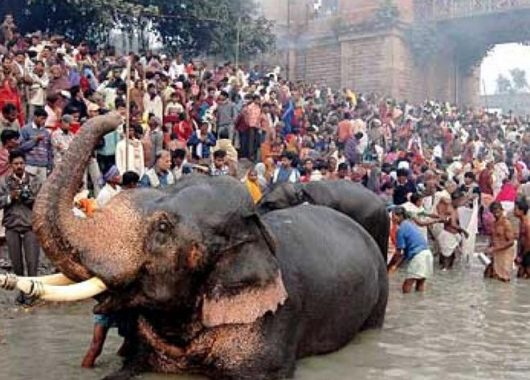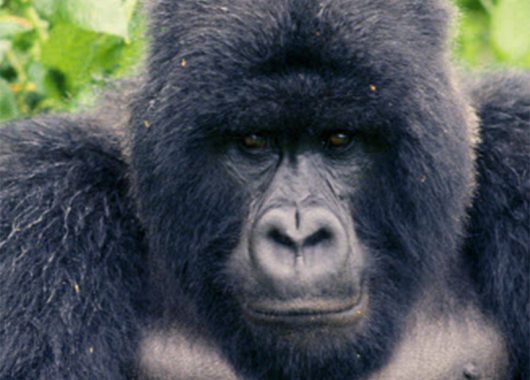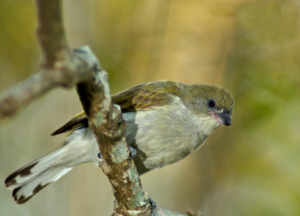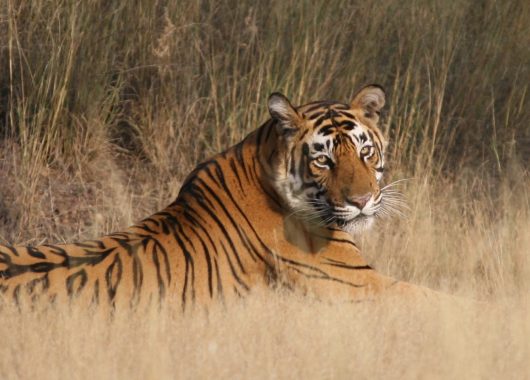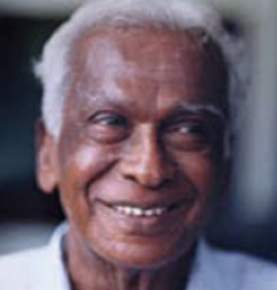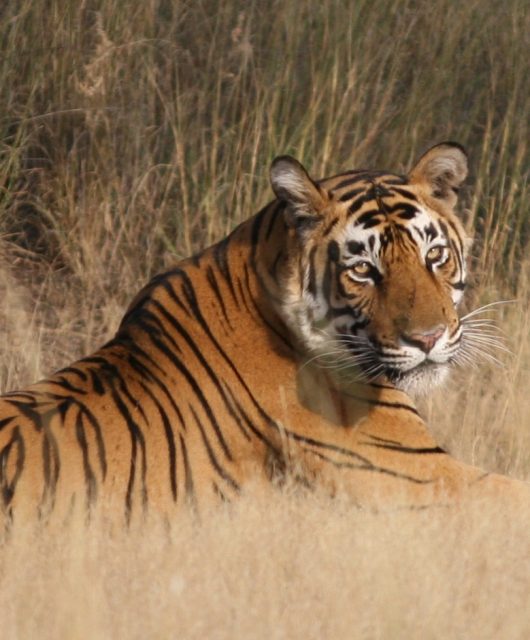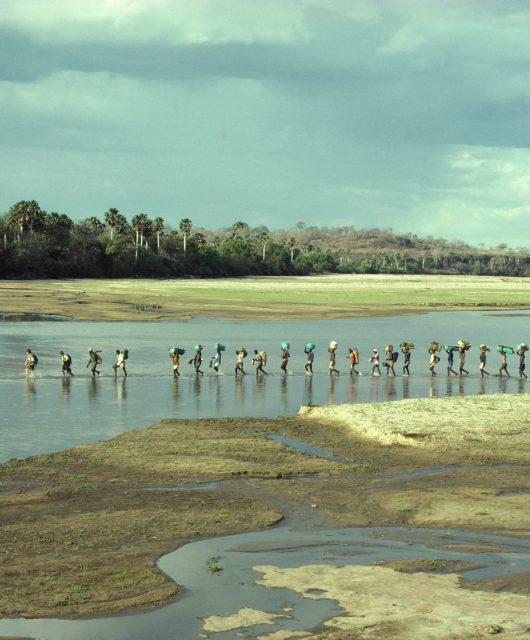Dolphins
This article originally appeared in the December 1990 edition of Harpers & Queen.
When I began investigating dolphins, I heard an almost unbelievable tale. Jojo, a dolphin who has taken up residence next to the Club Mediterranée in the Turks and Caicos Islands, likes to cause mischief among the guests. When the Club holds scuba-diving courses, the instructor needs to give a circle of students underwater lessons in the manipulation of their equipment. Jojo likes to choose this moment to shepherd a small shark into the middle of the circle, and then he swims round the students preventing the shark from escaping. It is thought that, with the exceptional hearing of a dolphin, Jojo relishes the thumping from terrified hearts.
Could such a story be true? In recent years many astonishing claims have been made for dolphins. Apart from an advanced sense of mischief, it is said that they have extraordinary intelligence, a special affinity with man, a sixth sense, and mysterious powers of healing. These claims have become even more extravagant now that the animals have attracted attention from the Short-Cut-to-Paradise brigade. Anyone who has dabbled with Est, worshipped the Maharishi, studied the healing power of crystals, undergone rebirthing, or joined a tantric workshop, is likely to be turning their attention to dolphins. Marine-mammal experts often refer to these people as ‘Crystals’.
In order to investigate their dramatic claims for myself, I visited two ‘swim-programmes’ where the public pay to swim with captive dolphins, and I went to four destinations where it is possible to swim with completely wild ones.
My first destination was Dolphins Plus, a swim-programme in the Florida Keys. Several acquaintances had told me that their visits here had been among the most extraordinary events of their lives. My own experience turned out to be different. The first shock was the ugliness of the place. The initial impression is of the tall chain-link fences surrounding the pools where the twelve dolphins are kept. The pools are not on the edge of the sea, but located off a drab sea-canal in a scabby suburb of Key Largo.
The ten of us who were going to swim paid $60 at a kiosk for the half-hour session, and there was, of course, an additional fee for the hire of flippers. After changing in a wooden hut smelling of urine, we were marshalled for a pep-talk. Our mentor told us not to grab the dolphins, and not to worry if they became sexually excited. We were also told how wonderful it was for the dolphins to live in such a comfortable hotel, and how nice it was for them not to have to search for their own food. He said that the dolphins were often taken for trips to the sea, and he laid great emphasis on their use for therapy with handicapped and autistic children.
As I was already becoming cynical, I asked the mentor, Lloyd Borguss, how often the dolphins were taken out to sea. He answered that he couldn’t be precise about this because there was no regular programme. I also asked which day was set aside for the children’s therapy. He said that no particular day was allocated. I later read in a government draft-report on swim-programmes that only 2 per cent of the sessions at Dolphins Plus are allocated for child therapy.
After our talk, the customers were allocated their enclosures, and my party of six plunged in among six female dolphins, who are kept in a pen the size of a large swimming-pool. During the half-hour we swam in the cloudy water, the dolphins showed no interest in any of us. They just cruised below. In the afternoon I paid for one more session, and there was still no interest. Later I stayed as a spectator for another session, but I never saw a single dolphin show interest in anyone. This may have been an off-day, but the dolphins’ boredom is not surprising. Four times a day, day after day, complete strangers plunge uninvited into their cramped territories. Apart from the dreariness of this routine, the dolphins must have learnt that it is important not to develop attachment to any swimmer, because the favoured visitor is unlikely ever to be seen again.
The defenders of Dolphins Plus point out that any interaction with the public is at lease spontaneous, not the result of bribery with fish. And the animals do have an escape area for avoiding unwelcome visitors. But none of this alters the fact that all twelve dolphins were caught in the wild, where they live in complex highly social groups, inhabiting a home-range which is likely to be more than 40 square miles. They are now confined to pens that are smaller than a municipal swimming-pool.
After the depression of Dolphins Plus it was a joy to be with Ron Canning in Key West. He specialises in taking people to see a school of 26 wild dolphins. On my first trip the two other customers were fine examples of Crystals. One of them later invited me to watch a video of underwater birthing (the babies just popped out); the other, a teacher of feminist spiritual ballet, was bringing her five-month-old baby to watch the dolphins. While pregnant, the mother had ‘rebirthed’ herself for two months, using a snorkel in the bath. She told me that the baby had spoken to her before it was born – the first time to tell her that he was Prince of the Starry Dolphins, then later to inform her that he had become King of the Starry Dolphins. I asked how he had managed to communicate with her. She said, ‘By telepathy’.
After 40 minutes sailing in Ron’s white catamaran, the sea’s luminous blue turned to a pale shade of green, the colour of a fresh spring leaf. This was shallow water with a sandy bottom, the present territory of the dolphins. We sailed in circles for an hour, but saw only flapping pelicans and the occasional turtle. Just as I was losing hope, Ron pointed at nine dolphins who were leaping towards us like salmon. They came right up to the bow, where we were sitting, and swam just beneath our feet. It was wonderful to see their faces so clearly, and to hear them snuffle as they came up for air.
Ron Canning, who is sensitive about relations with the dolphins, would not allow us to swim yet; instead we settled to watch them. After my experience at Dolphins Plus it was inspiring to see them hurl themselves clear into the air, often leaping backwards with a glistening display of silver-pink belly. Occasionally they played with a fish, which they hurled repeatedly in the air, and sometimes they mated, which they do face to face, like us. They are mammals, with the same body temperature as ours. Their babies, which are born after about eleven months’ gestation, suckle milk from their mothers’ retractable teats.
After a while the dolphins slowly moved away, so Ron Canning decided to attract them by towing me behind the boat. Equipped with a face-mask so that I could see through the water, I lay on my stomach, holding an aquaplane, a square wooden board which, when it is tilted, carries the swimmer effortlessly under the surface.
I first knew the dolphins were approaching when I heard a series of clicks, like a rapid Geiger counter. Dolphins use a wonderfully precise echo-location, similar to that of bats, which enables them to ‘see’ with the aid of sound. They send out these clicks, and by interpreting the returning echo, they are able to compose a precise picture. In tests with blindfolded dolphins, they have been able to distinguish between coins made of gold, silver, copper or steel. The nearly-extinct Ganges River dolphin, which is almost completely blind, moves and feeds entirely by using this echo-location. Soon after I heard the clicks, six dolphins swam past, now uttering little squeaks. They disappeared, and then returned, making graceful sideways curls while they peered at me through the clear blue water.
CAN CAPTIVITY BE JUSTIFIED?
Before going to visit Jojo, I went to another of Florida’s swim programmes, the Dolphin Research Centre.
At first sight it was more cheerful than Dolphins Plus, being right on the sea, and having much lower fences. The dolphins also appeared to be more animated and friendly. The Dolphin Research Centre claims that this is because none of their dolphins has more than two hours of human encounter each week, far less than Dolphins Plus. Critics, however, are quick to point out that the Research Centre uses the reward system (giving fish) right through the encounters, making it impossible to gauge the genuine interest of any dolphin.
My own encounter was certainly very structured. After diving into one of the enclosures, I was told to lie flat on my back, so that the dolphin could push me with its beak against my feet. The instructor then told me to make some movements for the dolphin to copy. I turned round and round, which was duly imitated, then make a blubbery noise with my lips, which the dolphin successfully copied through its blow-hole. I then shook my head from side to side; the animal approached closer, gazed at me sideways, then blew a spout of water in my face.
Animal-rights groups take a dim view of these tricks, and campaign vigorously against all four swim-programmes that are licensed in the United States. When defending itself, the centre says ‘Look at those low fences; the dolphins could jump to freedom at any time they liked’. The critics reply that certainly the dolphins could in theory jump over those fences, but they never will. The dolphins, they say, are broken animals who are now psychologically ill-equipped for the open sea. They will stick to their homes, just as a dog will stick to whatever master it has been allocated.
The government is going to reconsider all the swim-programme licences in 1991, so these institutions are energetic with propaganda. Their most publicised boast is their therapy for handicapped children, for instance those with learning difficulties or Down’s Syndrome. There has been a flurry of magazine articles, illustrated with photographs of apparently smiling dolphins facing angelic children. What most of the articles don’t make clear is that the smiling dolphin is there only because a trainer is holding a bucket of fish behind the angelic child. Nor have I seen it written that the Dolphin Research Centre charges $125 a session.
My own scepticism was increased because neither the Dolphin Research Centre nor Dolphins Plus was prepared to discuss their therapy with me. I wrote several letters requesting an interview, but none was ever granted.
Does the therapy have any validity? Like any questions concerning dolphins, there is no clear answer. I frequently changed my mind, usually converted by the last person I spoke to. Certainly when I discussed it with Kathy Anderson on the telephone, it was difficult to be cynical. Her four-year-old son, Dean-Paul, suffers from Down’s Syndrome. When he was two-and-a-half she took him to Oklahoma City Dolphinarium, where she says the dolphins showed a remarkable interest in him. Ever since then, whenever possible, she has taken her son to meet dolphins, and has many convincing and moving stories of their tenderness to Dean-Paul. She is sure that his association with them has had a tremendous effect on his ability to communicate; and although she has little money, she has no regrets about the $125 per session she spends on therapy.
I also had a long telephone conversation with Dr Betsy Smith who was the pioneer of therapy with dolphins. She explained that when therapy with pets (such as dogs with old people) was a growing phenomenon, she was keen to experiment with dolphins, who happened to be available in Florida. She is not a Crystal, and doesn’t think all dolphins possess a magic that makes them suitable for every type of therapy. But they do often like children, and even initiate contact with them. They give exceptional delight and stimulation to autistic children, whom Betsy Smith takes for therapy. Being very honest, however, she admits that ‘control’ tests (i.e. giving children alternative stimulation and comparing the difference) offer as yet little scientific evidence that dolphins are in any way more effective for treatment than other methods of stimulation.
She still continues to conduct therapy sessions, which she clearly thinks have value. But in our conversation she did make one attitude entirely clear: whatever the benefits of child therapy, they do not justify the capture of one single dolphin from its natural habitat. And she will never again allow the publication of one of her child-with-dolphin photographs.
If Betsy Smith’s views aren’t heeded, there will be a proliferation of swim-programmes throughout the world. These institutions can be exceedingly profitable, and they will be eager to use child-therapy as a front to gain respectability. It is unlikely that the US Government will allow more licences within the United States, but a swim-programme is already being planned for Spain, and many more will sprout in the Caribbean, where tourist-hungry impoverished governments will be free with their licences.
Whatever the disadvantages of swim-programmes, they are nothing like as bad as dolphinariums, all of which should be closed immediately. The public think that the captive dolphins are happy because they see them ‘smiling’ and because they appear to do their tricks for fun: if you study the shows closely, you will see that they are always given a reward of fish immediately after any trick. Rick O’Barry, who trained five famous television Flippers, explained to me that once the dolphin has eaten its fill, or once the trainer’s bucket is empty, then the dolphin will refuse to perform.
It is appallingly cruel to enclose in a tiny concrete pool an intelligent animal that swims dozens of miles a day in an open and varied sea. Most pools offer a brutal, sterile environment, with no natural light, and no natural sea-water. The filtration equipment rarely copes effectively with the three pounds of excrement and nine pints of urine that each dolphin excretes every day. Chlorine and other chemicals have to be added which are irritating to the skin and eyes of the dolphins.
With their astonishing echo-location, dolphins live in a world of sound, and therefore suffer from the echoing tanks, the roar of filter-plants, and the frequent pop music. They are usually trained with a system of food deprivation, and as an alternative discipline, are often locked into small pens. Is it surprising that so many captive dolphins die young, often of stress-related diseases such as bleeding stomach ulcers? Cousteau claimed that his own captured dolphins committed suicide.
When the dolphins are first captured in the sea, the mortality rate can be more than 50 per cent. The US Government has cut back on live captures, but there is always someone else to provide. At present Europe’s main supplier is Cuba.
Dolphins are also being captured for military purposes. They were first used by the American forces in the sixties, mostly to locate expensive equipment. Their first use in action came with the Vietnam War when they were trained to locate enemy divers. It is thought that at this stage they weren’t used for killing; but a renegade trainer, Rick Trout, now claims that, by using a spring-loaded device attached to their beaks, they are able to kill an enemy frogman. The Americans are constantly trying to improve training techniques, because, they claim, the Russians are also training dolphins in the Black Sea.
The US Congress has licensed the Navy to capture 25 dolphins in a year without any supervision from the normal wildlife laws; this is apart from the live ones it imports from Japan. It is also proposed that sixteen dolphins should be used for guarding the nuclear submarine base at Bangor. Animal rights groups are vigorously opposing this, pointing out that the water at Bangor is 24 degrees colder than the water in Mexico Bay, where the dolphins will be captured. One dolphin taken to Bangor died of heart failure within eleven days.
ARE DOLPHINS EXCEPTIONALLY INTELLIGENT?
Jojo, the aforementioned dolphin that liked to tease scuba-divers, is known as one of the friendliest dolphins in the world. I went to visit him in the Turks and Caicos islands, which are close to the Bahamas. Jojo’s home range is right next to the Club Mediterranée where he is able to indulge in his penchant for teasing. He knocks water-skiers off their balance, manipulates the rudders of sailing boats, and pulls dinghies out to sea. This love of teasing is a recurring theme in dolphin stories from every part of the world. The spectacular piece of mischief recounted at the beginning of this article was told to me by so many reliable people that I became convinced of its authenticity.
Jojo is also a minor nuisance when, with visible signs of sexual arousal, be rubs himself against the Club Mediterranée’s guests. He prefers large fat targets, with a mild preference for women. At one stage the problem got so bad that the Club hired a ‘dolphin psychologist’ to deal with him. This person swam frequently with Jojo and, whenever he became amorous, she would immediately wag her finger, turn her back, and leave the water – thus making him feel lonely. Since then, a wag of the finger, coupled with a firm ‘no’, has usually succeeded in reducing the dolphin’s lust.
Equally extraordinary is Jojo’s relationship with Dean Bernal, a former scuba instructor at the Club. They swim together every day, and have developed a remarkable level of communication. Dean told me how Jojo had recently played the game of taking him to lobsters. Jojo nudges his elbow, then indicates the way by leaving a faecal trail. As he gets closer, he chatters and gives blasts from his sonar. Sometimes he leads Dean, by taking his hand between his teeth; luckily he knows precisely how long Dean can last without air.
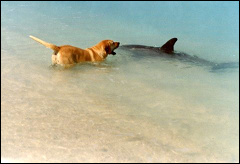
I hoped that Jojo would visit my hotel beach, for on arrival he indulges in boisterous play with the hotel’s Labrador, Toffee. The dog starts barking a long time before the dolphin’s appearance, and it is thought that he picks up a high-frequency sound. As Jojo never turned up at the hotel, I first met him on the next island when he was ‘asleep’, circling under the catamaran of Tim Ainley. Tim told me not to disturb him at this stage, which probably wouldn’t last for more than an hour. The dolphin doesn’t return the same respect: when bored at night, he bangs the catamaran’s dinghy against its hull, until Tim is woken and obliged to jump into the water for a game.
When Jojo had woken from his semi-comatose state, Tim gave two of us a tow on aquaplanes behind the catamaran. Jojo loves swimming with someone being towed by an aquaplane, but for most of the way he swam with the other person, not me. He has a precise hierarchy of friendship and likes to stay with those people that he knows best. I was somewhat jealous but as if to console me, he came over for a few moments to swim belly-up, just underneath me.
It must be emphasised that Jojo, and the other friendly dolphins I was later to visit in Ireland and Northumberland are completely wild animals. They are never fed. It is not surprising that Plutarch claimed that a dolphin is the only animal that likes human beings for their own sake. Why do dolphins deliberately make friends with people? The experts can’t agree on a reason for this, indeed can’t deem to agree on anything to do with dolphins. My layman’s belief is that the especially friendly dolphins have for some reason been rejected from their group, and being used to continual social interaction, they try replacing their fellow dolphins with humans. Jojo’s behaviour seems to support this theory, for when he senses that other dolphins are nearby, he rushes away in a fright. And it is clear that, although schools of dolphins (such as Ron Canning’s) show an interest in people, they aren’t as keen as the solitary ones to play with us.
Most of us have heard the ancient Greek and Roman fables about various dolphin friendships with human beings. As early as 343 BC, a Greek coin showed a man riding on a dolphin who befriended a boy, drawing huge crowds to the town of Hippo on the North African coast. It is strange that nearly 2,000 years elapsed before the recent outbreak of long-term contacts. The first well documented one was between 1955 and 1956 – a dolphin in Opononi, New Zealand, who played with many humans (as well as a favoured spaniel). It became a much loved celebrity, and was given the name ‘Opo’. She played tricks with beach balls, and even used to give a young girl, Jill Baker, short rides on her back. In 1972 a friendly dolphin appeared in the north-west of Spain, and frolicked with, among others, Franco’s grandchildren. The same year, Donald, the Isle of Man dolphin, first arrived and his relationships with humans were recorded for the next four years by Horace Dobbs, the doyen of British dolphin-watchers. At any given moment, there are usually about six specially friendly dolphins in European waters.
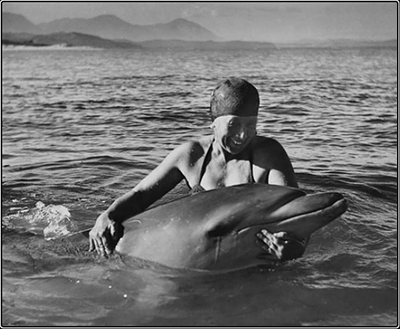
Some of the increase in contact can be explained by the modern use of diving equipment and wet-suits, which has made contact more feasible in cold waters. But this can be only a partial explanation, for it doesn’t account for the increase in warm-water contact which is mysterious and a seductive subject for cogitation by Crystals.
Unfortunately the Crystals tend to be gullible, and end up making excessive claims. The truth about dolphins is in itself so extraordinary that there is no need for the present spate of unsubstantiated hype. In the Greenpeace Bookshop in Key West I found a massive pile of Lana Miller’s Call of the Dolphins. It cost $12.95 and clearly sells very well to gullible readers. In a sane world it would never have been published. At one stage the author describes a séance where one of the guests ‘took a series of gasping-like breaths and suddenly a dolphin’s voice burst though’. The dolphin invited questions, and the author, being practical for a change, asked ‘Where can we come and play with you?’. The dolphin replied that he always enjoyed ‘playtime with all of you in dreamtime, just as you know physical times’. At another session she asks if dolphins are calling us to recreate the lost continent of Atlantis.
Occasionally I was myself misled by Crystals. In a Key West newspaper I saw an article about a woman who entices dolphins by playing the flute. The article was accompanied by a large photograph. Greatly excited, I went to the newspaper’s office to follow this up, then contacted the woman. In fact there was no interesting story: she had been playing the flute at the edge of a swim-programme’s enclosure; the camera had been carefully positioned to avoid the wire netting.
Needless to say, the Crystals believe that the dolphins have an incalculable intelligence. If you argue with this, they reply that we are judging dolphins by human criteria, whereas dolphin intelligence can be judged only by its suitability for their own environment. This is a fair comment, but by the same token a sea-slug could be considered cleverer than Leonardo da Vinci. If they are to be judged by our own criteria – the ability to remember, to work things out, and so on – I would judge from my own experience and reading that they have about the same intelligence as sheepdogs, which is saying a lot. If dolphins really were more intelligent than this, I think that the extraordinary news would be more widely known. Dr Lilly, who desperately wanted to find evidence of a prodigious dolphin intellect, spent years studying the animals and their methods of communication. He, and his followers, have managed to make them understand more than 40 words and even some complete sentences. But they never got much further than this, and never succeeded in teaching the animals a language to communicate back to us.
When associating with dolphins I was struck by the fact that some of their behaviour is child-like or dog-like, rather than comparable to a more sophisticated being. For instance I could keep the Irish dolphin’s attention for an indefinite length of time merely by swinging an anchor in front of him, an anchor that he had seen numberless times before.
On one topic I am completely with the Crystals, and disagree with the academic naturalists. When the latter write about animals, they consider it taboo to credit any creature with human emotions. They shrink at describing affection, mischievousness, humour, melancholy or joy (have they ever kept a dog, one wonders?). And if they are obliged to write about any such emotions they are sure to fiercely deny being anthropomorphic. After the reported rescue by a dolphin of a shipwrecked sailor, a naturalist told newspapers that no dolphin would ever deliberately save someone; he was obliged to give a convoluted explanation of how the animal must have been following some instinct, which accidentally led to the lucky sailor’s rescue. The naturalist should read Horace Dobbs’ description of how a dolphin surfaced under his son and carried him in triumph around the harbour of Port St Mary.
THE CRYSTALS SCORE A POINT
I went to County Kerry, in Ireland, with a party of sixteen to visit Fungie, a massive eleven-foot dolphin, who six years ago set up his territory in Dingle Bay. Some of the party were a little crystallised, and it was inevitable, for instance, that when we swapped addresses, we should also give our signs of the zodiac. The evenings’ diversions could include a session of touch-therapy or a discussion on the virtues of dowsing. But none of this was compulsory, and no one ever showed the slightest resentment if I took a more cynical line. A nicer bunch of people couldn’t be found; we spent a week together, and I have rarely enjoyed myself so much.
On our first morning, before breakfast, we all plunged into the sea in our rented wet-suits. Fungie gave most of us the once-over, but made the most fuss of our leader, Robert Barnes, leaping completely out of the water just by him. Robert was the only one of us who had met Fungie before (eight months previously), and although it may have been a coincidence, I felt that the Crystals were probably right when they claimed that the dolphin recognised him.
As summer advances, Fungie gets spoilt for company, and will pick and choose those whom he favours most. (This is unlike February, when, after the lonely months of winter, he is ecstatically pleased to see any swimmer.) Our party, however, did have a novelty which gave Fungie immense pleasure. Robert Barnes had brought a copy of Ron Canning’s aquaplane. Every time one of us was towed with it, Fungie was delighted – a delight which the local fishermen said would probably last for a week. My turn came last, but he still wasn’t bored, swimming right next to me, and frequently brushing my body.
Occasionally, through my face mask, I would see him plunging right down, almost out of sight, getting enough depth for a spectacular leap of joy right up above me. When crashing down, his body would slightly touch mine; fortunately his precision is remarkable, for to receive a 600 lb dolphin on one’s head would be devastating. In the six years that Fungie has been in Dingle, he has never badly hurt anyone.
One evening I went out late to the bay in order to avoid the midday crowds. Fungie had chosen for his territory a landscape that couldn’t be improved. In the distance was the mountainous range of Macgillicuddy’s Reeks; on one side was a tiny white lighthouse, on the other a decayed stone tower; across the bay irregular stone-walled fields ran down to modest cliffs which sheltered a copse of sycamores. I spent every evening here, watching Fungie until he left for fishing. He often made a clear signal of his departure: before leaving the bay he would hit the water with a noisy smack of his tail.
On this evening the calm of the bay was interrupted by a speedy inflatable manned by four Irishmen. Fungie rushed to join it, for he will abandon almost any swimmer for a fast boat. After the inflatable had sped round the bay a few times, the Irishmen generously invited me to join the fun by holding on to the side. Fungie then swam so close that I was able to stroke his flank, finding that his skin wasn’t covered with the expected fishlike slime, but instead felt something like satin. Its smoothness was occasionally notched by the scars carried by all wild dolphins (photographs of a smooth shiny dolphin usually indicate that it is a captive).
At one stage Fungie disappeared, and I thought this was the end of my fun. But soon I was astonished to see him ahead of me hanging vertically in the water; he had taken up; a position so that when the inflatable carried me past, my face was only a few inches away from a pair of enquiring eyes.
A WARM ENCOUNTER IN COLD WATER
Dolphins are as varied in character as humans. Freddie the Northumberland dolphin is unlike his counterpart in Ireland: he is less choosy about his human friends, and he is extraordinarily keen on physical contact. When he first appeared four years ago at Amble, he wouldn’t allow boats, let alone people, anywhere near. Bit by bit he became friendlier. The breakthrough came in June last year: it had been noticed that fishing line was tangled round one of his fins, and a skilful dolphin enthusiast had managed to untangle it. Since then Freddie has been one of the friendliest dolphins in the world.
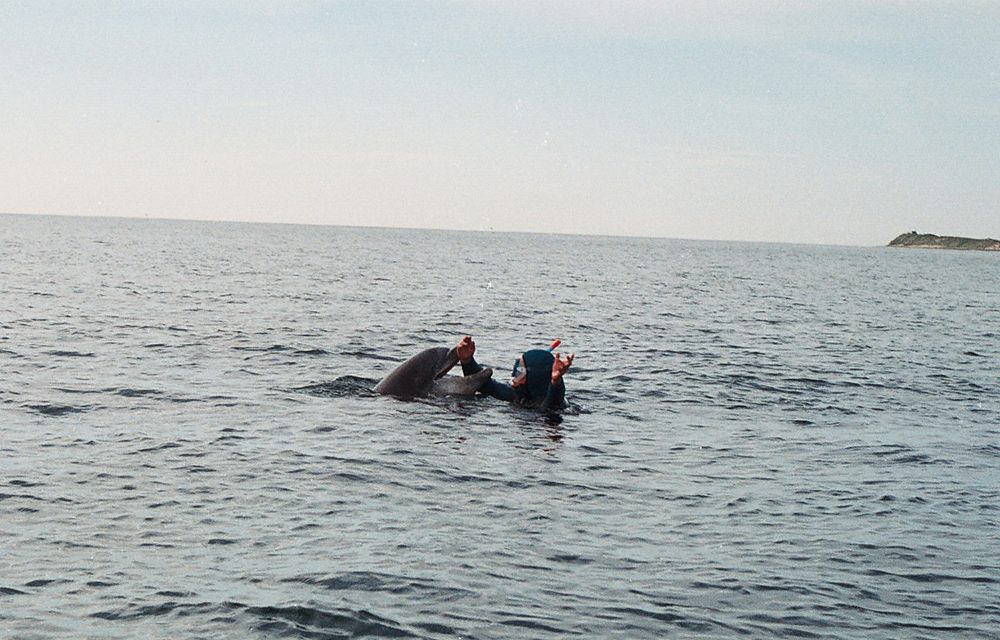
Gordon Easton, a lifeboat man who devotedly visits the dolphin every day, took me out on to the dark sea at 6 am. Freddie immediately rushed to our boat, and when I jumped into the water, he arrived upside-down beneath me. After I had stroked his silver skin, he turned over and slowly brushed against my shoulder. In the Turks and Caicos I had been instructed never to grab a dolphin, always to let it take the initiative. I had meant to do the same here, but quite unconsciously I took hold of his dorsal fin and was at once given a ride through the top of the water. Whatever the academic naturalists may say, the ride was offered to give me pleasure: Freddie had begun with a series of slow movements, as if to settle me comfortably, and he then moved off faster and faster until the rushing water nearly knocked off my face-mask. He is perfectly aware that a rider needs air, for he never attempts to take anyone below water.
I presumed that this dorsal ride was quite usual, but during my four later swims with Freddie I was never offered it again. He was, however, keen on other types of play, which often reminded me of the frolics of a dog. Sometimes he wanted to play gently, and just be petted; sometimes he wanted to play roughly, and became boisterous. He would prod me in the chest with his beak, as if to say ‘Let’s liven this up a bit’, and then I felt inadequate, regretting that I wasn’t more of an athlete in the water. One feature of his games was astonishingly dog-like: on three occasions he surfaced to take my arm gently between his 80 conical teeth and lead me along with him.
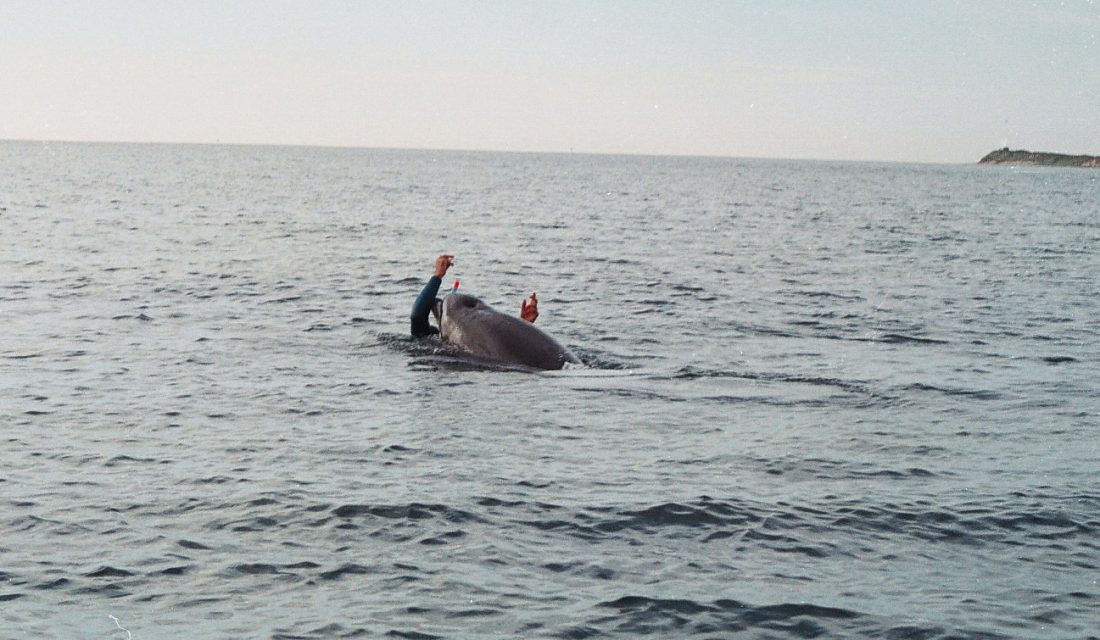
When he first did this I was mildly alarmed; but I needn’t have worried because he has only twice been unpleasant to swimmers. On both occasions a man and a woman were swimming hand-in-hand. Freddie appeared to be jealous. He swam between them, separating their hands, then thrashed about frighteningly and gave the man a mild thumping. As soon as one of them got out of the water he became friendly again.
On my last day in Amble, Horace Dobbs arrived, along with Bill Howell whom he takes out to dolphins as a treatment for his depressive illness. They were accompanied by a television team. When they allowed me to join them on the boat, I waited with keen interest to see what would happen, because I knew that two other dolphins (Simo in Pembrokeshire and Fungie in Ireland) had both taken a special liking to Bill. I also knew that this was surprising in Fungie’s case, as he much prefers women, children, strong swimmers or people he already knows well. Bill, who is in his fifties, somewhat overweight, and almost motionless in the water, doesn’t fit any of these categories.
When we reached the area that is Freddie’s territory, Bill got into the water along with four others – Eileen, a sultry beauty from Breakfast Television, the two cameramen, and Horace Dobbs. Freddie ignored them all, even Horace, who has such empathy with dolphins. At one stage Horace, who was worried that the current was carrying Bill away, swam over to shout that Bill should return in our direction. But as Horace approached, Freddie extended his retractable penis (which dolphins sometimes use as a tool), hooked it round the back of Bill’s knees, and pulled him further out to sea. Although all the swimmers followed, the dolphin remained cemented to Bill, who eventually rejoined us.
Back in my guest-house after this outing, Bill told me how he had suffered a horrendous depression between 1974 and 1985; during those eleven years he had never once smiled nor been able to communicate with his loving family. His life was transformed by his meeting with Horace Dobbs, and the subsequent encounters with dolphins. From every one of these encounters he remembered something special, and one of his memories nearly turned me into a Crystal.
He told me that, when he was swimming one morning in Dingle Bay, he felt a slap on his flippers. It was Fungie, who then nudged along the length of his body, uttering repeated squeaks. He then appeared in front of Bill, with a large salmon held sideways in his mouth. Bill, who used to be a chef, says that it was the largest salmon he’d ever seen. Not realising that dolphins quite often bring presents of fish, Bill thought that Fungie wanted the salmon repositioned for easier swallowing, so he shifted the fish round, and popped it down the dolphin’s throat. Fungie dived away, then slowly swam back up to him regurgitating the salmon scales, which Bill said looked like an explosion of shooting-stars scattering in the thick green haze of the Irish Sea.
![]()
NOTES
WARNINGS
During menstruation, women shouldn’t swim with male dolphins, as they can react frighteningly. Don’t touch near the dolphin’s blowhole. Don’t swim with a cold or disease, as it might be transmissible.
BOOKS
Horace Dobbs’ four books in print are The Magic of Dolphins (Lutterworth), Follow a Wild Dolphin (Souvenir), Tale of Two Dolphins (Cape), and Dance to a Dolphin’s Wild Song (Cape). Encounters with Whales and Dolphins by Wade Doak (Hodder) is a thorough description of the phenomenon of contact with human beings. Whales, Dolphins & Porpoises, ed by Sir Richard Harrison and Dr M Bryden, (Merehurst), is magnificently illustrated and has texts by specialists. The Greenpeace Book of Dolphins, edited by John May (Century), has interesting pictures and graphics, but is disappointingly lacking in detail.
TUNA
In the Eastern Tropical Pacific, yellowfin tuna swim underneath schools of dolphins. The by-product of catching these tuna is the slaughter of more than 100,000 dolphins each year. Dolphin massacres are also caused by massive drift-nets (they can be up to 37 miles long) which are used for catching skipjack tuna and other fish. Because it is hard to be sure of the origin of any tuna (it can be tinned thousands of miles from the catching-lace), you might consider boycotting all tuna until the food industry convinces conservation groups that the fish have been caught by methods harmless to dolphins.
![]()
Dolphins collaborating with fishermen on the Irrawaddy
With a small amateur camera I have taken six videos of a remarkable collaboration between fishermen and dolphins on the Irrawaddy in Myanmar. They are on the Links page.
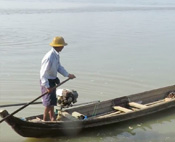
![]()
Articles by John Hatt
Other Articles
![]()
![]()


